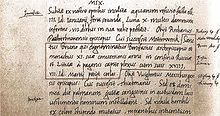Annals of Quedlinburg
 The first written instance of the name of Lithuania is in the Annals of Quedlinburg (1009) | |
| Original title | Annales Quedlinburgenses |
|---|---|
| Language | Latin |
| Subject | History |
The Annals of Quedlinburg (
Background

The city of
Annals
The Annals open with a chronicle of world history from the time of Adam to the Third Council of Constantinople in 680-681, based on chronicles by Jerome, Isidore, and Bede.[3] The narrative is largely borrowed from multiple older sources until the year 1002, although original reports from as early as 852 are present. Beginning in 993, the narrative begins including events which represent the annalist's own eyewitness testimony concerning events at and around Quedlinburg.[3] The amount of detail increases significantly from 1008 onwards, leading some analysts to conclude that 1008 was the actual date that the Annals were first compiled, although Robert Holzman argues for a start date of 1000.[7] It has been suggested that the annalist temporarily abandoned the project between 1016 and 1021.[3] The exact reasons for this suspension of the work are unknown. Work on the project continued between 1021 and 1030, when its authors were able to report a military victory against Mieszko II Lambert, King of Poland.
The primary task of the annalists was to record the heritage of the
The Annals of Quedlinburg became an important research source; during the 12th century they were used by at least five contemporary historians. Felice Lifshitz asserts that the Annals of Quedlinburg played a key role in shaping the ways in which influential
Mention of Lithuania
The first written occurrence of Lithuania's name has been traced to the Quedlinburg Annals in the descriotion of year 1009.[10][11] The passage reads:
Sanctus Bruno qui cognominatur Bonifacius archepiscopus et monachus XI. suæ conuersionis anno in confinio Rusciæ et Lituæ a paganis capite plexus cum suis XVIII, VII. Id. Martij petijt coelos.[12] "Saint Bruno, also called Bonifacius, an archbishop and monk, in the eleventh year of his convertion, was slain by
(Regarding the translation of "VII. Id. Martij": in Roman calendar dates were counted backward from three specific points in the lunar month. In this particular case, "VII. Id. Martij" literally means 7th of the Ides of March", i.e., around 15-7 = 8th or 9th of March.[14])
From other sources that describe Bruno of Querfurt, it is clear that this missionary attempted to Christianize the pagan king Netimer and his subjects.[15] However, Netimer's brother, refusing to accept Christianity, killed Bruno and his followers. The historian Alfredas Bumblauskas has suggested that the story records the first baptismal attempt in the history of Lithuania.[15]
Editions and translations
- Latin edition (including the Annals of Hildesheim and Weissemburg): MGH SS 3, pp. 18f.
- Giese, Martina, ed. (2004). Die Annales Quedlinburgenses (in Latin). Hannover: Hahnsche Buchhandlung. . Scriptores rerum Germanicarum in usum scholarum separatim editi», 72).
- The Annals of the Holy Roman Empire. The Annals of Quedlinburg. Translated and annotated by Grzegorz Kazimierz Walkowski (Walkowski, Bydgoszcz, 2014) ISBN 978-83-930932-6-7
References
- ISBN 0-7190-4926-1.
- ^ "TO MARK THE MILLENNIUM OF LITHUANIA". Directorate for the Commemoration of the Millennium of Lithuania under the Auspices of the Office of the President of the Republic of Lithuania. Archived from the original on 3 October 2008. Retrieved 2008-09-02.
- ^ a b c d e f g Lifshitz, Felice (January 13, 2006). "Review to: Giese, ed., Annales Quedlinburgenses". The Medieval Review. Indiana University.
- ^ "Quedlinburg UNESCO World Heritage". UNESCO. Archived from the original on 2008-06-16. Retrieved 2008-09-02.
- ^ ISBN 9986-830-89-3
- ISBN 978-0-521-36447-8.
- ^ ISBN 978-0-8020-7879-7.
- S2CID 127398721. Archived from the original(PDF) on 2011-10-21. Retrieved 2008-09-02.
- ISBN 978-0-19-511191-0.
- ISSN 0024-5089. Archived from the originalon 2021-07-09. Retrieved 2015-10-24.
- ISBN 1-57607-800-0
- ^ Albinus, Petrus Fabricius, Georg. Chronicon Quedlenburgense ab initio mundi per aetates. Retrieved on 2013-09-05
- ^ For Lithuania, a Millenium, Knight, vol. 31, no. 3, 2009
- ^ The Ides of March. Julius Caesar's Fateful Day
- ^ a b Alfredas Bumblauskas. Lietuvos tūkstantmetis – Millennium Lithuaniae Archived 2021-07-07 at the Wayback Machine. Retrieved on 2009-09-01
